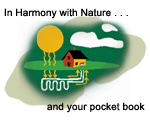| Efficiency | Sustainability |
|
|
Geothermal Heat Pumps
 Geothermal heat pumps are used to heat and cool a building as well as water heating by using the renewable energy of the sun stored just below the surface of the earth.
Geothermal heat pumps are used to heat and cool a building as well as water heating by using the renewable energy of the sun stored just below the surface of the earth.
It is sometimes referred to as a geoexchange, a ground source heat pump, a water source heat pump, green heat, or earth energy systems. No matter what you call it, geothermal systems are the best choice you can make for both your pocketbook and your planet. The U.S. Environmental Protection Agency has said they are, "the most energy-efficient, environmentally clean, and cost-effective space conditioning systems available today."
How it Works
The technology uses the stored solar energy beneath the surface of earth as it remains at a relatively constant temperature throughout the year, warmer than the air above it during the winter and cooler in the summer. The geothermal heat pump takes advantage of this by transferring heat stored in the Earth or in ground water into a building during the winter, and transferring it out of the building and back into the ground during the summer. The ground, in other words, acts as a heat source in winter and a heat sink in summer.
The only energy these systems require is a relatively small amount of electricity to run the compression cycle of the heat pump and to move the warm or cool air throughout the building, which means consumers can save 25 to 50+ percent, compared to traditional heating and cooling systems.
Geothermal heat pump systems use 4 basic ground loop configurations to turn backyards into a source of energy. Designs are chosen to suit the situation, depending on factors such as soils, groundwater availability and size of the yard.

Geothermal Contact:
Robert Walger
Project Manager – Geothermal Heating & Cooling
Energy
Government of Manitoba
1200 - 155 Carlton Street
Winnipeg MB R3C 3H8
Tel: (204) 945-7905
Fax: (204) 943-0031
Email: Robert.Walger@gov.mb.ca


